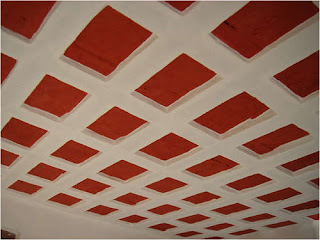In a simply supported RCC slab, the upper part of the slab is subjected to compressive forces while the lower portion is subjected to tensile forces. Concrete is very good in compression while it is weak in tension. Hence the steel reinforcement is placed in the tension zone. The concrete in this portion is only for holding together the steel reinforcement and has no structural purpose. This 'un-productive' concrete can be replaced by a 'Filler' material which will reduce the weight of the slab and also reduce the cost by reducing the amount of concrete used. Also, since the weight of the slab is thus reduced, lesser steel is also required for reinforcement, further reducing the cost.
- There is no reduction in the structural strength of the slab at all and it will act as a normal load bearing slab.
- Common filler materials are light weight materials like Mangalore tiles, clay pans, bricks, waste bottles, coconut shells, thermocol etc.
- Reduces the cost of the slab by around 25-30%
- Creates interesting designs and patterns on the ceiling
- Helps in better thermal insulation of the slab due to the air pockets present.
- Reduces the load on the foundation
Reinforced concrete
The filler slab is based on the principle that for roofs which are simply supported, the upper part of the slab is subjected to compressive forces and the lower part of the slab experience tensile forces. Concrete is very good in withstanding compressive forces and steel bears the load due to tensile forces. Thus the lower tensile region of the slab does not need any concrete except for holding the steel reinforcements together.
Therefore in a conventional RCC slab lot of concrete is wasted and it needs extra reinforcement due to added load of the concrete which can otherwise be replaced by low-cost and light weight filler materials, which will reduce the dead weight as well as the cost of the slab to 25% (as 40% less steel is used and 30% less concrete).
The filler slabs also result in fewer loads getting transferred to the load-bearing walls and the foundations. The air gap in between the tiles makes it a good heat insulator and the ceiling looks attractive as well.
The mechanism
The filler slab is a mechanism to replace the concrete in the tension zone. The filler material, thus, is not a structural part of the slab. By reducing the quantity and weight of material, the roof become less expensive, yet retains the strength of the conventional slab. The most popular filler material is the roofing tile. Mangalore tiles are placed between steel ribs and concrete is poured into the gap to make a filler slab. The structure requires less steel and cement and it is also a good heat insulator.
Strength of filler slabs.
Conventional tests by different institutions and laboratories has proved the load bearing capacity of filler slab and found it no less in performance from the conventional R.C.C. slab. Since filler roof tiles are firmly bonded to and covered by concrete, it does not collapse under the impact of say, a coconut falling on the roof.
Leak proofing filler slabs.
With proper supervision and workmanship, leaks can be avoided. The chance of a leak in a filler slab is much the same as the conventional R.C.C.slab.
Saving on cost
The savings on cost can be from 15 per cent to 25 per cent. But designing a filler slab requires a structural engineer to determine the spacing between the reinforcement bars.
Other favored filler materials include clay pots, stabilized mud blocks, brick or brick panel, broken pieces of cement blocks and even coconut shells. The quantity of concrete in the tension zone of the slab that can be replaced by a filler material depends upon the shape of the filler material and the thickness of the solid slab.
Thermal insulation
The air pocket formed by the contours of the tiles makes an excellent thermal insulation layer. The design integrity of a filler slab involves careful planning taking into account the negative zones and reinforcement areas.
Patterned ceilings
Filler slabs provide aesthetically pleasing patterned ceilings. In most houses, the filler material is left open without plastering to form aesthetic design symmetry but some residents prefer to cover the space with Plaster of Paris coating.
Thus the filler slab as the roof has the following advantages:
- Consumes less concrete and steel due to reduced weight of slab by the introduction of a less heavy, low cost filler material like two layers of burnt clay tiles. Slab thickness minimum 112.5 mm.
- Enhances thermal comfort inside the building due to heat-resistant qualities of filler materials and the gap between two burnt clay tiles.
- Makes saving on cost of this slab compared to the traditional slab by about 23%.
- Reduces use of concrete and saves cement and steel by about 40%.










2 comments:
Can you explain how it is done? Are these filler materials are placed on the formwork under the steel bar? or in between the steel bar?
Thanks so much for a great post. I'd like to know more about these topics and hope that I can receive more insight into this topic.
nose fillers
bellafill vs voluma
derma fillers
silicone filler
fillers for wrinkles
smile line fillers
wrinkle filler injections
fillers for nose
cosmetic fillers
fillers for smile lines
permanent dermal fillers
smile lines treatment
permanent facial fillers
artefill filler
artefill for lips
injectable wrinkle fillers
Post a Comment